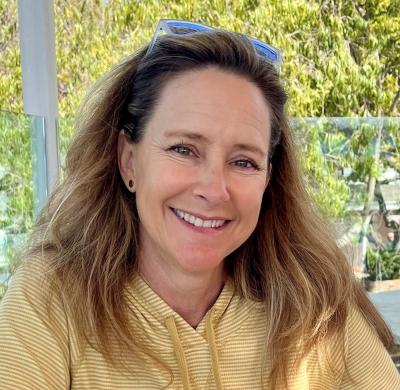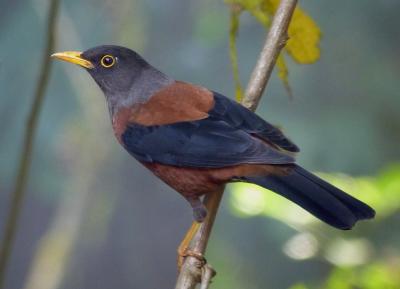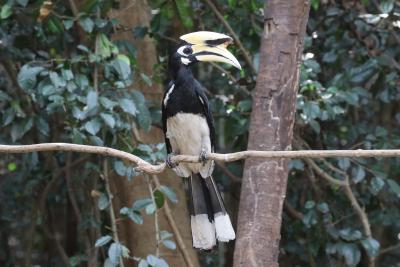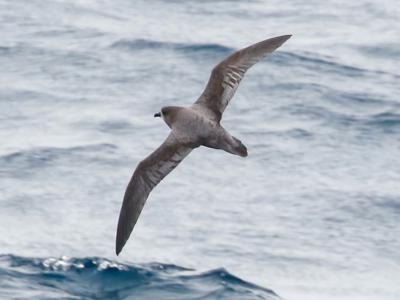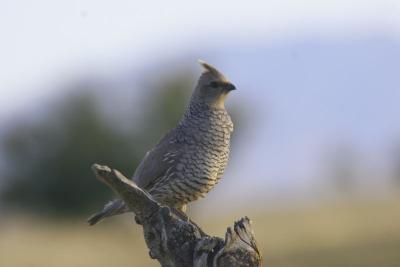Idaho: Cassia Crossbill and Southern Idaho
-
Aug 15-24, 2025
Jon Dunn
In 2017 the AOS Checklist Committee agreed after extensive research by Craig Benkman that the endemic subspecies of Red Crossbill from Idaho’s eastern Twin Falls and Cassia Counties was a full species, the Cassia Crossbill (Loxia sinesciurus). The translation of the species name, sinesciurus, literally means “without squirrels,” and indeed Red Squirrels are absent from the two mountain ranges where this species occurs. The Lodgepole Pine cones there have evolved in the absence of squirrels and so have the crossbills. We’ll spend at least one full day in the heart of the Cassia Crossbill’s range in the South Hills, and we have an excellent chance of both seeing this species and hearing its fairly distinctive calls.
There is, of course, much more to see in the South Hills, including a variety of montane species, and hummingbirds should be at their peak numbers. In addition, we’ll visit Boise National Forest northeast of Boise with hopes for a fine mix of woodpeckers including Lewis’s and the sagebrush areas and grasslands around Pocatello where we have a good chance for Ferruginous Hawk, and with luck we might see Burrowing Owl and Prairie Falcon. Our tour coincides with the peak of fall shorebird migration, and we’ll have numerous opportunities to study this compelling group. Idaho is lightly populated, and the scenery will be endlessly spectacular with majestic mountain ranges and verdant and sagebrush covered valleys.
Day 1: The tour begins with an early evening meeting in the lobby of our hotel followed by dinner. Night in Boise.
Day 2: We’ll depart for the beautiful Sawtooth Range in Boise National Forest where our prime ornithological targets are woodpeckers. Some ten species are found here, and we’ll follow the latest reports in our search for key species like White-headed, Black-backed and American Three-toed Woodpeckers. Williamson’s and Red-naped Sapsuckers are also possible, as is Pileated Woodpecker. In addition, we should see coniferous forest species including Canada and Steller’s Jays, Clark’s Nutcracker, Mountain Chickadee, and Red-breasted and White-breasted (interior lagunae subspecies group) Nuthatches and Red Crossbill. In 2021 we even found a pair of White-winged Crossbills, a three crossbill species tour. Night in Stanley.
Day 3: This morning we will search again for woodpeckers in the Stanley area, notably around Stanley Lake, along with other mountain species including Mountain Bluebirds. Sandhill Cranes and Pronghorn should be numerous in the large meadows in the area. Our route today includes spectacular scenery, and we’ll crest several passes—the Galena Summit is nearly 9,000 feet—before descending to the famous Sun Valley ski resort. In 2022 we saw a road killed American Marten indicating the presence of this scarce mammal. Later we will arrive in Twin Falls where after check-in and dinner we might have some time for a bit of birding around the area, notably the falls themselves where we might see White-throated Swift. Night in Twin Falls.
Day 4: We’ll depart Twin Falls for the South Hills, one of the two mountain ranges where the endemic Cassia Crossbill is found. We’ll focus on finding and hearing the distinctive (from other Red Crossbill types) calls on this recently split species. We should see as well many other birds including Common Nighthawk, Western Wood Pewee, Dusky and perhaps Hammond’s Flycatchers, Black-capped Chickadee, Lazuli Bunting, and Yellow-breasted Chat (we should at least hear it) along the streams, and Canyon Wren on the steep cliffs. We’ll also check a local hummingbird feeding station (Brockman’s), where at this time of year dozens of hummingbirds of four species (Black-chinned, Broad-tailed, Rufous and Calliope) are usually present. The nearby beaver ponds have Spotted and Green-tailed Towhees, and “Slate-colored” Fox Sparrow is possible. In addition to the birds we might see Moose and Mule Deer. This evening, if conditions warrant, we’ll venture back into the South Hills along North Cottonwood Creek to try for Common Poorwill. At a riparian clump along the way various riparian birds nest and migrants are possible and in 2021 Blue Grosbeaks nested. Night in Twin Falls.
Day 5: If we’re completely satisfied with our Cassia Crossbill experiences, we’ll drive south to the southern Magic Valley on the west side of the South Hills. Early in the drive we might see individual or family groups of Gray Partridge along the roadsides as well as a variety of sparrows, including possibly Grasshopper and Brewer’s. In a roadside windbreak of trees we have seen Barn and Great Horned Owls and we’ll watch for Burrowing Owl. We’ll continue farther west to Salmon Falls Creek and Roseworth (Cedar Creek) Reservoir for various water birds, including migrant shorebirds. In the sagebrush areas we should find Sage Thrasher and we have a good chance of seeing Sagebrush Sparrow. At another grove of junipers along a grassland watercourse we’ll check for Long-eared Owl, and we’ll be watching the sky for a Golden Eagle. On the return to Twin Falls we’ll check ponds where migrant shorebirds are possible depending on the water level. Baird’s, Least, and Western Sandpipers are regular visitors and we have a chance for Solitary Sandpiper and Wilson’s and Red-necked Phalaropes. Both Eastern and Western Kingbirds could be present in the open country or in riparian areas, although most will have departed, and Swainson’s Hawk should be numerous. After a bit of rest and dinner, we might make another try for night birds, notably Common Poorwill. Night in Twin Falls.
Day 6: If for any reason we are still missing Cassia Crossbill, we’ll drive east and south to the Albion Mountains where we have an excellent chance of seeing them. Other species might include Clark’s Nutcracker and maybe Williamson’s Sapsucker. White-crowned Sparrows (oriantha) breed here along with Dark-eyed Juncos. Interestingly we found both “Gray-headed” and “Pink-sided” Dark-eyed Juncos, both seeming to be pure phenotypes. Since these likely were breeding birds, it makes one wonder if these two might actually be separate species. Later we’ll continue south to Oakley, not far from the most scenic City of Rocks National Reserve. Night in Almo.
Day 7: This morning we’ll visit the City of Rocks National Reserve. In addition to pinyon-juniper species including Woodhouse’s Jay and with luck roving flocks of Pinyon Jays, we might see Virginia’s and with luck Black-throated Gray Warbler. Juniper Titmice, Blue-gray Gnatcatcher (western subspecies obscura), and perhaps Plumbeous Vireo (in higher aspen stands) should be present and we might see Say’s Phoebe and Gray Flycatcher and perhaps a late Ash-throated Flycatcher. We’ll also watch for a passing White-throated Swift or a Prairie Falcon. Later, and to the north we’ll visit Lake Wolcott State Park where we’ll have lunch and search for early fall migrants among the Black-capped Chickadee flocks, including Cassin’s Vireo, and Yellow, Wilson’s and perhaps Nashville Warblers (Pacific ridgwayi subspecies). Franklin’s Gulls will be numerous along the river. Later in the afternoon, we’ll stop at American Falls Reservoir which can be good for water birds, including Clark’s and Western Grebes. Night in Pocatello.
Day 8: We’ll spend the morning birding around Pocatello looking for, Chukar, Woodhouse’s Scrub-Jay, Juniper Titmouse and Blue-gray Gnatcatcher all near our hotel. From here we’ll drive south to the Arbon Valley where we should have good chance for Ferruginous Hawk and Prairie Falcon along with a variety of sparrows including Brewer’s and Vesper, and with very good luck, Sharp-tailed Grouse. After a picnic lunch on Scout Mountain, we’ll stop on the way back to Pocatello at Kinney Creek trail in Mink Canyon where we have seen Gray Flycatcher, Plumbeous Vireo, Juniper Titmouse, and on single occasions Ruffed Grouse and Virginia’s Warbler. Night in Pocatello.
Day 9: This morning is flexible depending on what species we may have missed around Pocatello. Not far away is American Falls Reservoir and depending on water levels it can be an excellent location for migrant shorebirds along with hundreds of Franklin’s Gulls and American White Pelicans. Here we have an excellent chance to compare Forster’s and Common Terns. The riparian woodland along the southwest shore of the reservoir can be productive for migrant land birds. From here we’ll drive west via Interstates 86 and 84 and should arrive in Boise by late afternoon. Night in Boise near the airport.
Day 10: The tour concludes after breakfast in Boise.
Note: The information presented below has been extracted from our formal General Information for this tour. It covers topics we feel potential registrants may wish to consider before booking space. The complete General Information for this tour will be sent to all tour registrants and of course supplemental information, if needed, is available from the WINGS office.
Please take a moment to read the About WINGS Tours section of the WINGS website. This section contains important information about how we conduct tours, e.g., what is included in the tour price, refund and cancellation policies, pace of the tours and other information that will help you prepare for the tour.
ENTERING THE UNITED STATES: Non-U.S. citizens will need a valid passport and may need a tourist visa or visa waiver. Please consult your nearest U.S. Embassy or consulate for details. Canadian citizens need to carry proof of citizenship in the form of a passport.
PACE OF THE TOUR: This is a fairly relaxed tour, apart from early mornings (breakfast at 0600), particularly if it is hot, which it certainly can be in August. We drive to nearly all of the birding locations with walking limited at any one spot to about a mile. The pace will always be slow, especially at the higher elevations. There may be owling one or more evenings.
HEALTH: For information on US-based infectious disease outbreaks currently being reported by CDC, please see the CDC Current Outbreak List.
Altitude: We will be at elevations from about 2700’ to about 7000’, although on our second full day we may reach nearly 9000’ at Galena Summit. Unless there is an early cold front, it will likely be somewhat cool in the morning, especially at higher elevations, and then become warm to even hot. It is extremely important to stay hydrated and be alert to the effects of altitude. If there is a cold front it can be quite cool, and indeed cold and perhaps windy (and wet) at higher elevations.
Smoking: Smoking is prohibited in the vehicles or when the group is gathered for meals, checklists, etc. While in the field or traveling, use of a smokeless alternative such as nicotine gum is requested. Please do not smoke at short stops while traveling. If you smoke in the field, do so well away and downwind from the group and leave ample time between smoking and getting back into the vehicle. If you are sharing a room with a non-smoker, please do not smoke in the room. If any lodge, accommodation or location where the group is staying or is gathered has a more restrictive smoking policy than WINGS’ policy, the more restrictive policy will prevail. The leader reserves the right to modify this policy if the situation warrants it.
Participants should bring an adequate supply of any personal medications as they may be difficult to obtain during the tour.
CLIMATE:
It is still quite warm to hot in Idaho in August, unless there is an unexpected early cold front which would bring cooler temperatures and possibly rain, and more likely wind. Thunderstorms are also possible. Lows will be in the 50’s and 60’s (cooler in the mountains) and highs can reach the low to mid- 90’s, though in hotter years temperatures have reached up to the 100’s. In recent years, fires are not infrequent in our western forests in summer and fall. In 2021 it was smoky on several days, the smoke originating from fires in central Oregon.
ACCOMMODATIONS: We will be staying at standard motels and/or lodges throughout the tour. Our hotels offer free wifi access.
FOOD: We’ll eat in a variety of local restaurants where the food will in most cases be American standard. Breakfasts are generally taken in our hotels (continental plus), and lunches will be in local or chain sandwich stores or cafes, or often picnics if the group prefers and if the plan for the day requires this.
WINGS tours are all-inclusive and no refunds can be issued for any tour meals participants choose to skip.
Food Allergies / Requirements: We cannot guarantee that all food allergies can be accommodated at every destination. Participants with significant food allergies or special dietary requirements should bring appropriate foods with them for those times when their needs cannot be met. Announced meal times are always approximate depending on how the day unfolds. Participants who need to eat according to a fixed schedule should bring supplemental food. Please contact the WINGS office if you have any questions.
TRANSPORTATION: We will be traveling by 15- [or 12-] passenger window van or minivan, depending on the group size. When using the larger vans, we will take a maximum of seven passengers plus the leader/driver. Participants should be able to ride in any seat in tour vehicles and will be expected to change seats daily.
2022 Narrative
IN BRIEF: The highlight of our southern Idaho tour was highlighted by Cassia Crossbill in the South Hills. We obtained recordings of their calls which were confirmed by Austin Young. During the tour we recorded nine species of woodpeckers including Lewis’s, White-headed and a single American Three-toed. Shorebirds were numerous and included a scarce (for Idaho) juvenile Stilt Sandpiper and an adult Pectoral Sandpiper. Other highlights included Gray Partridge, Chukars (flock of 20 at one spot), Ferruginous Hawk, Long-eared Owls and plenty of Sage Thrashers along with several Sagebrush Sparrows. Franklin’s Gulls were locally abundant. A long-staying adult Neotropic Cormorant along the Snake River in Twin Falls was most unexpected. We tallied 154 species.
IN DETAIL: Our tour began with a drive to Idaho City along the Boise River, then along Moores Creek. We noted a few Ospreys as well as two Wild Turkeys (introduced). We visited feeders at a local’s home. Her yard was full of birds. We were greeted by two Evening Grosbeaks, our only ones of the trip. She was most gracious and birded with us around her yard. There were lots of hummingbirds visiting her feeders, notably Rufous, Black-chinned (the most numerous species) and Calliope. Cassin’s Finch was the most numerous passerine but there were also Pine Siskins and Lesser Goldfinches. The abundance of birds also attracted a Cooper’s Hawk. We were particularly keen on woodpeckers that were visiting her suet feeders. These included a Hairy, but more importantly two White-headed Woodpeckers, a scarce and local species in Idaho, here at the eastern limit of its range. Two White-breasted Nuthatches were of the subspecies tenuissima of the “interior West” subspecies group, very likely a separate species from the eastern and Pacific groups of subspecies.
Later in the morning we headed gradually north and east noting a few species, notably Black-headed Grosbeaks and Western Tanagers. We stopped north of Stanley to admire Pronghorn and family groups of Sandhill Cranes. At a nearby burn we saw two Downy Woodpeckers, but more importantly we had excellent views of a drumming female American Three-towed Woodpecker (subspecies fasciatus). This is the first time we have recorded this uncommon species on the tour. It is worth noting that at the very same burn a year ago we had a single Black-backed Woodpecker. These two related species in the genus Picoides are both attracted to burns, particularly Black-backed Woodpecker. Here we heard a Townsend’s Solitaire. That evening, after checking into our hotel in Stanley, we had a delicious dinner at the Sawtooth Hotel.
The next morning after a yummy breakfast at the Stanley Baking Company, we drove north towards Lake Stanley, stopping briefly in town to compare Cliff and Violet-green Swallows. We also noted several Mountain Bluebirds, the state bird of Idaho. Near Lake Stanley we slowly birded a forest noted for woodpeckers and noted a juvenile male Williamson’s Sapsucker and a Pileated Woodpecker, another trip first. A female Red Crossbill was also seen along with a few Golden-mantled Ground Squirrels and Red Squirrels. At Lake Stanley we had exceptionally good views of several Western Tanagers, including an adult male. The main highlight was a family group of Canada Jays that passed through. On the lake itself, a female Bufflehead with an accompanying duckling were present along with Common Mergansers. A breeding plumaged Eared Grebe was for a time just a few feet away. On the way back out we had nice views of a Clark’s Nutcracker.
We then headed south towards Sun Valley, a world-famous ski area. Just south of Stanley we had good views of a Prairie Falcon and also noted a juvenile Red-naped Sapsucker on a telephone pole well away from taller trees. On the south side of Galena Summit we stopped for a road killed American Marten, an animal that I’ve never seen in life, but have noted three road kills now. From here it was a steady drive through Ketchum and Hailey, and we eventually arrived in Twin Falls. After checking in to the Hampton Inn and carefully protecting (!) our room keys, we had an early dinner at La Fiesta Mexican Restaurant, and then headed south to North Cottonwood Creek on the north side of the South Hills. We saw numerous Lark Sparrows and at one riparian area saw five Sage Thrashers, Yellow Warblers and heard a Yellow-breasted Chat. Several Common Nighthawks passed over as dusk approached and at dusk we had excellent views of several Common Poorwills on the road. On the way out we flushed a Great Horned Owl along the side of the road.
The next morning we headed right up into the South Hills in search of the Cassia Crossbill. Initially the birding was slow with no crossbills. We did note and study several Common Nighthawks that were flying about. Later, we stopped at a burn on the way to Hummingbird Bar and here we found Cassia Crossbills, the same place we found them the year before. We got recordings of their calls which were confirmed by Austin Young, our co-leader on the previous three tours and who helped to originally organize the tour. He knows the Cassia Crossbill well as he lives in southern Idaho, and most importantly knows their calls. Whether this taxon is more different from other types of Red Crossbills is a matter of debate. It was thought to be present only in the South Hills and the Albion Mountain, isolated ranges where Red Squirrels are absent and the lodgepole pine cones and crossbill (bills) have evolved differently from mountains where the squirrels are present. The specific epithet of Cassia Crossbill, sinesciuris, translates to “without squirrels.” Recently, I heard that they believe they have located Cassia Crossbills at a location in Colorado, although I do not know the details. Here we also saw many Cassin’s Finches and several female type Lazuli Buntings along with a juvenal plumaged Townsend’s Solitaire, and nearby also had an Olive-sided Flycatcher. At the burn multiple Lewis’s Woodpeckers were present, our 9th species of woodpecker of the trip. At the Brockman’s hummingbird feeding station, we had many hummingbirds of four species, including Broad-tailed which we studied and compared carefully to the Rufous and Calliopes. Several trilling adult male Broad-tails with their rose throats were present too. We also heard a Gray Catbird.
Later at two farm ponds east of Kimberly we found a variety of shorebirds, most notably including a scarce (for Idaho) juvenile Stilt Sandpiper. Other species included Black-necked Stilts and American Avocets, Lesser Yellowlegs, Semipalmated, Western, Least and Baird’s sandpipers, and Wilson’s and Red-necked Phalaropes. Three species of gulls, including some 75 Franklin’s, were present along with lots of waterfowl. At a nearby small pond we had excellent views of Northern Rough-winged Swallows and for the day in the lowlands we tallied some 20 Swainson’s Hawks. That evening we visited the “twin falls” at Shoshone Park for which the city is named. While the scenery was spectacular, birds were few in number.
The next morning we headed mainly south and west. Our first significant sighting was a perched adult Ferruginous Hawk. In the grasslands and sagebrush we were fortunate to find a single male Gray Partridge along the side of the road. Here Brewer’s Sparrows and Sage Thrashers were very numerous and for the day we tallied eight Loggerhead Shrikes. In a line of trees we noted a well-hidden Barn Owl. Later at the Simplof Pond west of Rogerson, where we were admiring Yellow-headed Blackbirds, a car pulled up and a lady held up her binoculars to indicate she was a fellow birder. She had lots of invaluable tips for us and spent part of the day birding with us. Our first stop, after stopping at Salmon Falls Reservoir, was the sagebrush a few miles west.
Here we obtained decent views of several Sagebrush Sparrows and also noted a single immature Golden Eagle. Farther west, at Cedar Creek Reservoir, we observed Clark’s, Western and Eared grebes along with a small flocks of Northern Pintail and White-faced Ibis. Shorebirds were sparse, but we spotted a Long-billed Curlew and a small group of four sandpipers which included a Pectoral (adult), two Western (adult and a juvenile) and a juvenile Semipalmated Sandpiper. The Long-billed Curlew was a tour first for us. They breed in southern Idaho, but most appear to leave by August. The Pectoral is an uncommon migrant in Idaho, and nearly all birds seen in the West are juveniles that appear later (September). The adults pass south some 1500 miles farther east in the Mississippi and Ohio Valleys. Later, and after the leader found the right road (!), we noted two Long-eared Owls (and Barn Owls and Common Nighthawks too) in the junipers on the road to Cooonskin Butte. On the drive we flushed numerous Horned Larks and Vesper Sparrows.
The next morning, our local fellow birder joined us along the Snake River in Twin Falls where with her assistance she spotted the rare Neotropic Cormorant, an adult on a rock with nearby Double-crested Cormorants. This bird has been present for months and I believe it is a 3rd state record. The species has been expanding its range to the north over the last decade. Three Common Goldeneyes were on another rock in the river. Here we also noted two White-throated Swifts with the swallows overhead and had excellent views of both Rock and Canyon Wrens and Blue-gray Gnatcatchers (western subspecies obscura). American Goldfinches were present too.
Our next stop was the parking lot at the Walmart in Burley where several Great-tailed Grackles maneuvered amongst the parked cars. At Lake Wolcott State Park amongst the tall trees we had a picnic lunch and listened to the singing Western Wood Pewees and Yellow Warblers. A few migrants were noted here too including a singing Cassin’s Vireo, a female Townsend’s Warbler and Wilson’s Warbler. A Hammond’s Flycatcher was briefly seen. At the spillway, Common Terns and some sixty American White Pelicans were present along with several hundred or more Franklin’s Gulls. From here we headed east, stopping briefly to scout the southwest side of American Falls Reservoir, before continuing on to Pocatello to the Holiday Inn Express which was on a hill overlooking the city. We dined at Portneuf Brewing.
After breakfast the next morning we stopped at a nearby location where we found Juniper Titmice and not far away we were able to locate twenty, or more, Chukars. One stayed out in the open for scope views. Bullock’s Orioles were also present. We stopped at the restrooms at Cherry Creek where a female Moose with an accompanying calf were present across the creek. Our walk along Kinney Creek was quiet, but we did have several Woodhouse’s Scrub-Jays along with a Gray and a Dusky Flycatcher and two Blue-gray Gnatcatchers. Up on Scout Mountain we had a picnic lunch and did a bit of birding noting numerous Red-breasted Nuthatches, a Warbling Vireo and compared Black-capped and Mountain Chickadees in a mixed flock.
Later we headed north towards Idaho Falls to look for a summering Long-tailed Duck. The pinned location we were given proved incorrect, although Spotted Sandpipers were numerous and we had good looks at a nesting Osprey and multiple Bank Swallows. Upriver we finally located the Long-tailed Duck, but by then the heat (nearly 100 degrees) was overwhelming. That night we had a very nice dinner at Jaker’s, very close to our hotel.
On our final day we started at American Falls Reservoir where we admired several adult Swainson’s Hawks and Bullock’s Orioles, all perched at very close range. We then headed to the dam area where we had a variety of shorebirds, Semipalmated (one), Least, Western, and a single Baird’s. An adult Long-billed Dowitcher in breeding (alternate) plumage was also present. Ducks were numerous (mostly Northern Shoveler and Green-winged Teal ), and we recorded a female Lesser Scaup and a several Redheads. Some 100 American White Pelicans were present. Passerine migrants were scarce and we noted only a single Black-headed Grosbeak. A juvenile Peregrine Falcon made a dive at the shorebirds near the dam. Perhaps most notable ornithological event was the excellent comparison of both Forster’s and Common Terns (both adults and juveniles). Also notable there was the swimming American Beaver that was close by. From here we drove west getting lunch at a roadside west along the interstate. By the time we arrived in Boise, the heat was searing, the high reaching 105 degrees. Since several of us had predawn flights, we chose to get an early dinner at the nearby Applebee’s rather than go into Boise.
- Jon Dunn
Maximum group size is six with two leaders.













































